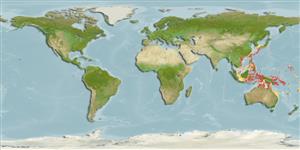Common names from other countries
>
Gobiiformes (Gobies) >
Gobiidae (Gobies) > Gobiinae
Etymology: Eviota: No etymology given, suggested by Christopher Scharpt: from Latin 'eu' for 'true' and 'iota' for anything very small, in combination 'truly very small' referring to it as being the smallest vertebrate at the time it has benn described by Jenkins (thus, making the suggestion by Scharpt plausible.; fallax: Name from Latin word 'fallax' meaning deceitful, false; refers to its superficial similarity to Eviota natalis; noun in apposition..
Environment: milieu / climate zone / depth range / distribution range
экология
морской ассоциированный с рифами; пределы глубины 8 - 31 m (Ref. 79588), usually 8 - 15 m (Ref. 79588). Tropical
Western Pacific: Indonesia (Bali, West Papua, Banda, and Sangihe Island), Papua New Guinea (Kimbe, New Britain), Solomon Islands, Philippines, Micronesia (Chuuk, Yap, and Ngulu Atoll), and Japan (Ryukyu Islands).
Size / Вес / Возраст
Maturity: Lm ? range ? - ? cm
Max length : 1.8 cm SL самец/пол неопределен; (Ref. 79588)
Краткое описание
определительные ключи | морфология | морфометрия
колючие лучи спинного плавника (общее число) : 7; членистые (мягкие) лучи спинного плавника (общее число) : 9; колючие лучи анального плавника: 1; членистые (мягкие) лучи анального плавника: 8. This species is distinguished from its congeners by the following characters: dark occipital spot, more well-developed in males and in preservation; an orange spot behind the eye in life; cephalic sensory-pore system pattern Group I (complete); dorsal/anal formula often 9/8; eye diameter 26.7-34.4% HL; caudal-peduncle depth 10.9-12.4% SL; 4th pelvic-fin ray with short, thick branches bound together by membranes (Ref. 79588).
Inhabits rocky caverns or coral heads on sand seen most frequently at depths of about 8-15 m on either live coral (frequently faviids) or on rocky surfaces covered with coralline algae patches (Ref. 79588).
Life cycle and mating behavior
Maturities | размножение | Spawnings | Egg(s) | Fecundities | личинки
Greenfield, D.W. and G.R. Allen, 2012. Eviota fallax, a new dwarfgoby from the Western Pacific (Teleostei: Gobiidae). Zootaxa 3522:42-48. (Ref. 79588)
Статус Красного Списка МСОП (Ref. 130435)
CITES (Ref. 128078)
Not Evaluated
Угроза для людей
Harmless
Использование человеком
дополнительная информация
инструменты
Специальные отчеты
Скачать в формате XML
ресурсы в Интернет
Estimates based on models
Preferred temperature (Ref.
115969): 26.7 - 29.2, mean 28.7 (based on 662 cells).
Phylogenetic diversity index (Ref.
82804): PD
50 = 0.5000 [Uniqueness, from 0.5 = low to 2.0 = high].
Bayesian length-weight: a=0.01023 (0.00477 - 0.02194), b=3.02 (2.84 - 3.20), in cm Total Length, based on LWR estimates for this (Sub)family-body shape (Ref.
93245).
Trophic level (Ref.
69278): 3.0 ±0.3 se; based on size and trophs of closest relatives
Fishing Vulnerability (Ref.
59153): Low vulnerability (10 of 100).
